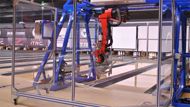USBC test robot E.A.R.L. makes engineering headlines
July 28, 2011

ARLINGTON, Texas – United States Bowling Congress (USBC) test robot E.A.R.L. recently made headlines as the cover story of Design News magazine’s Mechatronics supplement.
Design News is a leading technical resource, providing technology news, opinion, and analysis, for engineers and engineering managers. The article detailed how designers created E.A.R.L. (Enhanced Automated Robotic Launcher) with the ability to release a ball with precise accuracy under a wide range of velocity, loft and axis rotation variables.
“It is extremely flattering to receive this type of attention and have researchers outside the bowling industry interested in the work being done at USBC,” Neil Stremmel, USBC Managing Director of National Governing Body, said. “E.A.R.L. is a unique and innovative research tool that piques the interest of bowlers and techies.”
E.A.R.L. was used extensively in a recently-finished USBC static weights study. The study showed that if the current static weight limits were eliminated or increased, the typical three-phase motion of bowling balls as they travel down a lane (skid, hook, and then roll) would be significantly altered causing a fourth phase of unpredictable motion.
“E.A.R.L. played a key role in allowing the team to prove that current USBC static weight limits are still valid,” Stremmel said. “Having a precision test robot gives USBC another tool to create policy for the sport based on sound science and data-driven research.”
Newly released additional data and explanations of the static weights study are available by visiting BOWL.com/equipandspecs.
Design News is a leading technical resource, providing technology news, opinion, and analysis, for engineers and engineering managers. The article detailed how designers created E.A.R.L. (Enhanced Automated Robotic Launcher) with the ability to release a ball with precise accuracy under a wide range of velocity, loft and axis rotation variables.
“It is extremely flattering to receive this type of attention and have researchers outside the bowling industry interested in the work being done at USBC,” Neil Stremmel, USBC Managing Director of National Governing Body, said. “E.A.R.L. is a unique and innovative research tool that piques the interest of bowlers and techies.”
E.A.R.L. was used extensively in a recently-finished USBC static weights study. The study showed that if the current static weight limits were eliminated or increased, the typical three-phase motion of bowling balls as they travel down a lane (skid, hook, and then roll) would be significantly altered causing a fourth phase of unpredictable motion.
“E.A.R.L. played a key role in allowing the team to prove that current USBC static weight limits are still valid,” Stremmel said. “Having a precision test robot gives USBC another tool to create policy for the sport based on sound science and data-driven research.”
Newly released additional data and explanations of the static weights study are available by visiting BOWL.com/equipandspecs.





